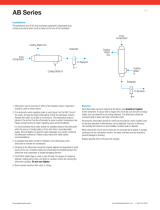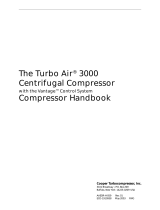Page is loading ...

thermaltransfer.com ttp-sales@apiheattransfer.com +1.262.554.8330
General Information
1. Side by side units are built for operation with maximum air and oil pressure
of 250 PSI and temperature of 350°F (176°C).
2. The motors furnished are built for fan duty. Consideration should be
given to the installation location so motors are not subjected to extreme
temperatures.
3. The “ACOC” coolers are not to be operated in ambient temperatures
below 35°F (1°C).
4. The fan cannot be cycled.
5. “ACOC” coolers operated outdoors must be protected from weather.
Consult factory for recommendations.
Installation
1. Units should not be located in corrosive atmospheres as rapid deterioration
of fan shroud, cooling coil, fan and motor may take place resulting in
reduced life.
2. Piping should be sized based on air flow and pressure drop requirements,
and not on the aftercooler’s supply and return connection size.
3. A strainer located ahead of the aftercooler should be installed to trap scale,
dirt or sludge that may be present in piping and equipment,
or that may accumulate with use.
4. A separator/trap/drain should be installed in the outlet piping of the
aftercooler to remove condensate.
5. Flexible connectors should be installed to prevent the stressing of
manifolds. (Must be properly installed to validate warranty.)
6. Arrange the outlet pipe so that the moisture that condenses within the
aftercooler can drain freely by gravity.
7. For proper air flow, a minimum of 12” clearance should be allowed
between the aftercooler fan and any wall or obstructions.
Electrical
1. CAUTION To prevent possible electrical shock, it is important to make sure
this unit is properly grounded.
2. Connect motor only to a power supply of the same characteristics
as shown on the motor nameplate. Be sure to provide proper fusing
to prevent possible motor burnout. Before starting motor, follow
manufacturer’s recommendations. Turn fan manually to eliminate possible
motor burn out in the event the fan has been damaged in shipment.
Observe operation after motor is started for the first time.
ACOC(H) Series
Maintenance
Inspect the unit regularly for loose bolts and connections, rust and corrosion,
and dirty or clogged heat transfer surfaces (cooling coil).
Heat Transfer Surface
Dirt and dust should be removed by brushing the fins and tubes and blowing
loose dirt off with an air hose. Should the surface be greasy, the motor should
be removed and the fins and tubes brushed or sprayed with a non-flammable
degreasing fluid. Follow with a hot water rinse and dry thoroughly. A steam
hose may also be used effectively. Do not clean with caustic cleaners
Fan Shroud, Fan and Motor
Dirt and grease should be removed from these parts. Rusty or corroded
surfaces should be sanded clean and repainted.
Internal Cleaning
Once a year piping should be disconnected and a degreasing agent or
flushing oil circulated through the unit to remove sludge from turbulators and
internal tube surfaces to return the unit to full capacity. A thorough cleaning
of the entire system in the same manner is preferable to avoid carry-over
from uncleaned piping, pump and accessories. The strainer of any filtering
devices should be removed and serviced following this cleaning operation.
Motor
Keep outside surface free of dirt and grease so motor will cool properly.
Make sure cooling air over motor is not obstructed. Ball bearing motors
are normally furnished and require lubrication every 6 months. If the motor
is equipped with Alemite fitting, clean tip of fitting and apply grease gun.
Use 1 to 2 full strokes on motors in NEMA 215 frame and smaller. Use 2 to
3 strokes of NEMA 254 through NEMA 365 frame. Use 3 to 4 strokes on
NEMA 404 frames and larger. On motors having drain plugs, remove grease
drain plug and operate motor for 20 minutes before replacing drain plug. On
motors equipped with slotted head grease screw, remove screw and apply
grease tube to hole. Insert 2 to 3 inch length of grease string into each hole
on motors in NEMA 215 frame and smaller. Insert 3 to 5 inch length on larger
motors. On motors having grease drain plugs, remove plug and operate motor
for 20 minutes before replacing drain plug. CAUTION Keep grease clean.
Lubricate motors at standstill. Do not mix petroleum grease and silicone
grease in motor bearings.
Repair or Replacement of Parts
When ordering replacement parts or making inquiry regarding service,
mention model number, serial number and the original purchase order
number. Any reference to the motor must carry full nameplate data.
0916

thermaltransfer.com ttp-sales@apiheattransfer.com +1.262.554.8330
1. The cooler storage area should be dry and maintained at a constant room
temperature.
2. In order to minimize and/or eliminate condensation (on both the inside and
outside surfaces of the cooler), coolers should not be moved from warm
areas to cold areas without prior adjustment of the room temperature in
order to minimize the temperature changes which result in condensation.
If this criteria cannot be met, the cooler shall be sealed in plastic bags with
desiccant added.
3. For coolers which will be stored up to a maximum of 6 months: No specific
internal corrosion protection procedures are required. All cooler openings
shall be sealed with plastic plugs.
4. For coolers which will be stored from 6 months to 24 months: These coolers
should be internally flushed with oil and all cooler openings sealed with
plastic plugs.
5. For coolers which will be stored for more than 24 months: These coolers
should be completely filled with oil and sealed. These coolers should then be
flushed, inspected, refilled with oil, and sealed every 24 months.
6. For compressor aftercoolers after installation:
6.1 Any condensation should be thoroughly removed from the aftercooler
after the initial trial run of the compressor.
6.2 In the event a compressor is to be stored, or not used for a period of 6
months to 24 months, the aftercooler should be internally flushed with
oil, and all cooler openings sealed.
6.3 In the event a compressor is to be stored, or not used for a period of
more than 24 months, the aftercooler should be completely filled
with oil and sealed. the aftercooler should then be flushed, inspected,
refilled with oil, and sealed every 24 months.
6.4 Prior to compressor start-up, any corrosion protection oil should be
removed from the aftercooler.
AHP(H) / AOL / ACOC(H) Series 0916
/










